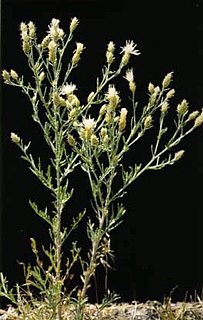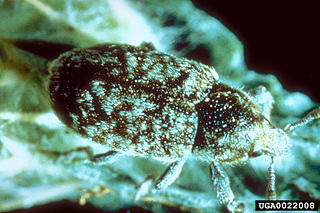
Centaurea is a genus of over 700 species of herbaceous thistle-like flowering plants in the family Asteraceae. Members of the genus are found only north of the equator, mostly in the Eastern Hemisphere; the Middle East and surrounding regions are particularly species-rich. In the western United States, yellow starthistles are an invasive species. Around the year 1850, seeds from the plant had arrived to the state of California. It is believed that those seeds came from South America.

Centaurea diffusa, also known as diffuse knapweed, white knapweed or tumble knapweed, is a member of the genus Centaurea in the family Asteraceae. This species is common throughout western North America but is not actually native to the North American continent, but to the eastern Mediterranean.

The Tephritidae are one of two fly families referred to as fruit flies, the other family being the Drosophilidae. The family Tephritidae does not include the biological model organisms of the genus Drosophila, which is often called the "common fruit fly". Nearly 5,000 described species of tephritid fruit fly are categorized in almost 500 genera of the Tephritidae. Description, recategorization, and genetic analyses are constantly changing the taxonomy of this family. To distinguish them from the Drosophilidae, the Tephritidae are sometimes called peacock flies, in reference to their elaborate and colorful markings. The name comes from the Greek τεφρος, tephros, meaning "ash grey". They are found in all the biogeographic realms.

Centaurea solstitialis, the yellow star-thistle, is a species of thorny plant in the genus Centaurea, which is part of the family Asteraceae. A winter annual, it is native to the Mediterranean Basin region and invasive in many other places. It is also known as golden starthistle, yellow cockspur and St. Barnaby's thistle.

Agapeta zoegana is a species of moth known as the sulphur knapweed moth and the yellow-winged knapweed root moth. It is used as an agent of biological pest control against noxious knapweeds, particularly spotted knapweed and diffuse knapweed.

Bangasternus fausti is a species of true weevil known as the broad-nosed seed head weevil. It is used as an agent of biological pest control against noxious knapweeds, particularly spotted knapweed, squarrose knapweed, and diffuse knapweed.
Chaetorellia acrolophi is a species of tephritid fruit fly known as the knapweed peacock fly. It is used as an agent of biological pest control against noxious knapweeds, especially spotted knapweed.

Cyphocleonus achates is a species of true weevil known as the knapweed root weevil. It is native to southern Europe and the Mediterranean and is used as an agent of biological pest control against noxious knapweeds, especially spotted knapweed. It has recently been spotted in India.
Larinus minutus is a species of true weevil known as the lesser knapweed flower weevil. It is used as an agent of biological pest control against noxious knapweeds, especially diffuse knapweed and spotted knapweed.

Larinus obtusus is a species of true weevil known as the blunt knapweed flower weevil. It is used as an agent of biological pest control against noxious knapweeds, especially spotted knapweed.

Larinus is a genus of true weevils, comprising about 180 species, mostly in the Palaearctic region. Turkey appears to have a significant diversity of the group, with more than 50 species recorded in the Eastern part of the country.

Metzneria paucipunctella is a species of moth known as the spotted knapweed seed head moth. It is used as an agent of biological pest control against noxious knapweeds, particularly spotted knapweed.

Larinus curtus is a species of true weevil known as the yellow starthistle flower weevil. It is native to Southern Italy, Southern Europe, the Middle East and the Caucasuses. It is used as an agent of biological pest control against the noxious weed yellow starthistle in the United States.
Centaurea virgata is a species of Centaurea. It is native to Western Asia. The subspecies C. virgata subsp. squarrosa is known as squarrose knapweed.

Urophora is a genus of tephritid or fruit flies in the family Tephritidae.

Urophora jaceana is a species of tephritid or fruit flies in the genus Urophora of the family Tephritidae. The host plant for the larvae is usually black knapweed or Centaurea debeauxii.

Urophora quadrifasciata is a species of tephritid or fruit flies in the genus Urophora of the family Tephritidae. The host plant for the larvae is usually a knapweed, and because of this, it is used to control Centaurea stoebe.

Centaurea stoebe, the spotted knapweed or panicled knapweed, is a species of Centaurea native to eastern Europe, although it has spread to North America, where it is considered an invasive species. It forms a tumbleweed, helping to increase the species' reach, and the seeds are also enabled by a feathery pappus.

Meadow knapweed is a fertile hybrid between black knapweed and brown knapweed. It is also known by the common names of hybrid knapweed or protean knapweed. The taxonomic status of the species is uncertain, and meadow knapweed has been variously described as different species. The Flora of North America refers to meadow knapweed as the nothospecies Centaurea × moncktonii.
















